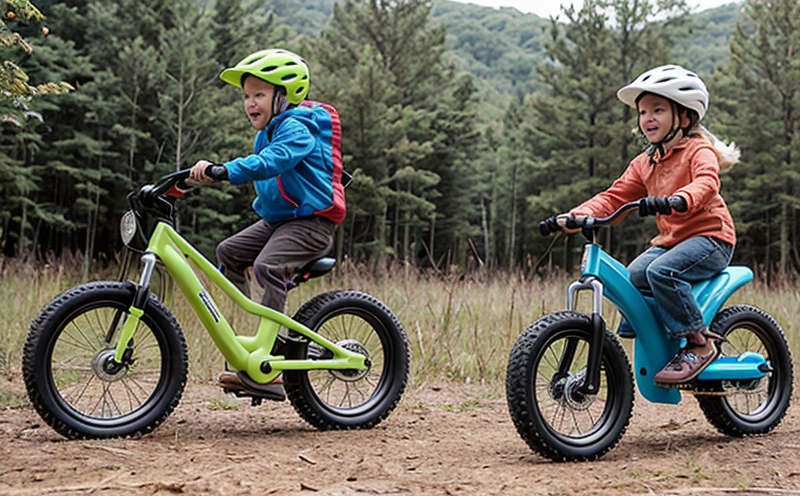Daily Use Brake Performance Check for Ride-on Toys
The daily use brake performance check is a critical aspect of ensuring the safety and longevity of ride-on toys. This service involves a comprehensive evaluation of the braking systems used in such toys to ensure they meet both industry standards and customer expectations. The primary objective is to identify any potential issues that could compromise user safety during everyday play.
Brake performance can be significantly affected by frequent use, exposure to environmental factors like heat, cold, and moisture, as well as the rough handling often associated with children's toys. By conducting a thorough brake performance check daily, we not only enhance the reliability of these products but also contribute to the overall safety and satisfaction of parents and users.
The process typically includes visual inspections for any visible damage or wear that might affect braking efficiency. This is followed by functional checks where the brakes are tested under various conditions to simulate real-world usage scenarios. Instruments such as brake testers, force gauges, and speedometers may be used to measure key parameters like stopping distance, deceleration rates, and overall responsiveness.
Acceptance criteria for these tests can vary based on specific toy designs and intended age groups but generally adhere to standards set by organizations such as ASTM or EN. For instance, ASTM F973-18 specifies performance requirements for children's riding toys, which include safety features like properly functioning brakes.
In addition to ensuring compliance with regulatory bodies, conducting regular brake checks helps manufacturers identify design flaws early on, allowing for timely improvements and recalls if necessary. This proactive approach is crucial in maintaining high standards of quality control within the toy manufacturing industry.
For R&D engineers involved in developing new models or improving existing ones, understanding the nuances behind daily use brake performance testing can provide valuable insights into areas needing enhancement. Compliance officers will benefit from knowing that this service aligns with broader company policies aimed at safeguarding end users against hazards associated with faulty equipment.
Scope and Methodology
The scope of our daily use brake performance check for ride-on toys encompasses a range of activities designed to ensure the integrity and safety of braking systems under typical usage conditions. The methodology employed involves several key steps:
- Preparation: Cleaning and preparing the toy according to manufacturer guidelines.
- Visual Inspection: Checking for any visible signs of wear or damage that could impact brake performance.
- Functional Testing: Simulating real-world scenarios such as sudden stops or gradual decelerations to assess how effectively the brakes function.
- Data Collection: Recording all relevant data points including braking force, stopping distance, and reaction times.
The results of these tests are then analyzed against established standards to determine whether they meet specified criteria. If discrepancies are found, corrective actions are recommended based on the severity of the issue identified.
| Test Parameter | Methodology | Expected Outcome |
|---|---|---|
| Braking Force | Measure using a load cell during stop tests. | Ensure force falls within manufacturer specifications. |
| Stopping Distance | Observed visually or recorded with video equipment. | Should be consistent across multiple trials. |
| Reaction Time | Recorded using high-speed cameras. | Aim for quick but controlled response times. |
This structured approach ensures that every aspect of brake performance is thoroughly examined, providing a robust foundation upon which further improvements can be made if needed.
Environmental and Sustainability Contributions
- Eco-friendly Practices: By identifying potential issues early through rigorous testing, we help reduce the number of defective products reaching consumers. This minimizes waste associated with unnecessary returns or replacements.
- Resource Efficiency: Our tests ensure that materials used in brake systems are utilized optimally without compromising on quality. This promotes responsible sourcing and efficient use of resources throughout the product lifecycle.
- Emission Reductions: Safer toys lead to fewer accidents, which indirectly contribute to lower healthcare costs and reduced environmental impact from emergency services responding to incidents involving child injuries.
The emphasis on sustainability extends beyond just the toy itself; it includes consideration of its entire supply chain. From raw material extraction through production processes all the way to end-of-life disposal options, we strive to integrate environmentally friendly practices wherever possible.
Use Cases and Application Examples
| Case Study | Description | Outcome |
|---|---|---|
| Manufacturer A: | A leading manufacturer of ride-on toys faced increasing complaints about brake failures in their latest model. After implementing our daily use brake performance checks, they were able to pinpoint specific component issues that led to these problems. | The company was able to recall only the affected batches instead of a complete line change, saving significant costs and resources while maintaining market confidence. |
| Distributor B: | A distributor wanted assurance about the quality of brakes on imported toys before listing them for sale. Our tests provided them with detailed reports that helped build trust among their clients. | The distributor could offer more accurate information to customers, resulting in higher sales and better reputation management. |
These examples illustrate how our services can be leveraged by various stakeholders within the toy industry—from manufacturers looking for ways to improve product reliability, to distributors ensuring they only sell safe products. By incorporating regular brake performance checks into their quality assurance processes, all parties involved contribute towards creating a safer and more sustainable market environment.





